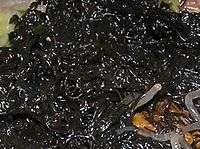Fat choy
Fat choy (Chinese: 髮菜; Nostoc flagelliforme) is a terrestrial cyanobacterium (a type of photosynthetic bacteria) that is used as a vegetable in Chinese cuisine. When dried, the product has the appearance of black hair. For that reason, its name in Chinese means "hair vegetable." When soaked, fat choy has a soft texture which is like very fine vermicelli.
| Fat choy | |
|---|---|
 | |
| Nostoc flagelliforme under a microscope | |
| Scientific classification | |
| Domain: | Bacteria |
| Phylum: | Cyanobacteria |
| Class: | Cyanophyceae |
| Order: | Nostocales |
| Family: | Nostocaceae |
| Genus: | Nostoc |
| Species: | N. flagelliforme |
| Binomial name | |
| Nostoc flagelliforme | |
| Synonyms[1] | |
| |
| Fat choy | |||||||||||||||
|---|---|---|---|---|---|---|---|---|---|---|---|---|---|---|---|
 | |||||||||||||||
| Traditional Chinese | 髮菜 | ||||||||||||||
| Simplified Chinese | 发菜 | ||||||||||||||
| Literal meaning | "hair vegetable" | ||||||||||||||
| |||||||||||||||
| Alternative Chinese name | |||||||||||||||
| Traditional Chinese | 頭毛菜 | ||||||||||||||
| |||||||||||||||
Production
Fat choy grows on the ground in the Gobi Desert and the Qinghai Plateau. Over-harvesting on the Mongolian steppes has furthered erosion and desertification in those areas. The Chinese government has limited its harvesting, which has caused its price to increase. This may be one reason why some commercially available fat choy has been found to be adulterated with strands of a non-cellular starchy material, with other additives and dyes.[2][3] Real fat choy is dark green in color, while the counterfeit fat choy appears black.[2]
Chinese culture
The last two syllables of this name in Cantonese sound the same as another Cantonese saying meaning "struck it rich" (though the second syllable, coi, has a different tone) -- this is found, for example, in the Cantonese saying, "Gung1 hei2 faat3 coi4" (恭喜發財, meaning "wishing you prosperity"), which is often proclaimed during Chinese New Year. For that reason, this product is a popular ingredient in dishes used for the Chinese New Year. It is enjoyed as an alternative to cellophane noodles. It is mostly used in Cantonese cuisine and Buddhist cuisine. It is sometimes used as a hot pot ingredient.
Vietnamese culture
Fat choy is also used in Vietnamese cuisine. It is called tóc tiên or tóc thiêng (literally "angel's hair") in Vietnamese.
Health effects
N. flagelliforme has no nutritional value, and also contains beta-N-methylamino-L-alanine (BMAA), a toxic amino acid that could affect the normal functions of nerve cells and is linked to degenerative diseases such as ALS, Alzheimer's, Parkinson's, and dementia.[4] May have positive effects in macrophages and splenocytes white blood cells.[5]
No significant difference between laboratory rats fed Nostoc flagelliforme and the control group was found in a study by Takenaka and coworkers.[6]
Notes and references
- Calvo-Pérez, Juan Diego; Molinari-Novoa, Eduardo A.; Guiry, Michael D. (23 March 2016). "Validation of Nostoc flagelliforme (Nostocaceae, Cyanobacteria)" (PDF). Notulae Algarum (2): 1–2. ISSN 2009-8987. Retrieved 15 January 2019.
- "The standard.com.hk". Archived from the original on November 22, 2007. Retrieved 22 October 2018.
- Waynesword
- The standard.com.hk. Mimi Lau, January 30, 2007, Ban sought on Lunar delicacy Archived November 22, 2007, at the Wayback Machine
- Ku, Lee (2013). "Edible blue-green algae reduce the production of pro-inflammatory cytokines by inhibiting NF-κB pathway in macrophages and splenocytes". Biochimica et Biophysica Acta (BBA) - General Subjects. 1830 (4): 2981–2988. doi:10.1016/j.bbagen.2013.01.018. PMC 3594481. PMID 23357040.
- Takenaka 1998.
Bibliography
- But, Paul Pui-Hay; Cheng, Ling; Chan, Pui Kwan; Lau, David Tai-Wai; But, Joyce Wing-Hin (2002). "Nostoc flagelliforme and faked items retailed in Hong Kong" (PDF). Journal of Applied Phycology. 14 (2): 143–145. doi:10.1023/a:1019518329032. ISSN 0921-8971. Retrieved 22 October 2018.
- Takenaka, H.; Yamaguchi, Y.; Sakaki, S.; Watarai, K.; Tanaka, N.; Hori, M.; Seki, H.; Tsuchida, M.; Yamada, A.; Nishimori, T.; Morinaga, T. (1 December 1998). "Safety evaluation of Nostoc flagelliforme (nostocales, Cyanophyceae) as a potential food". Food and Chemical Toxicology (United Kingdom). 36 (12): 1073–1077. doi:10.1016/S0278-6915(98)00089-1. ISSN 0278-6915. Retrieved 22 October 2018.
External links
- "Cyanobacteria Photos". waynesword.palomar.edu. Retrieved 22 October 2018.
- "food for thought". sg.bcmagazine.net. 1 February 2004. Archived from the original on 1 February 2004. Retrieved 22 October 2018.